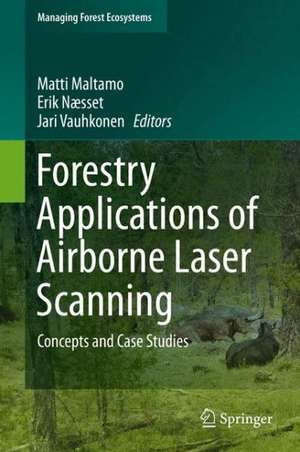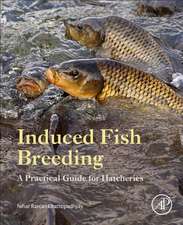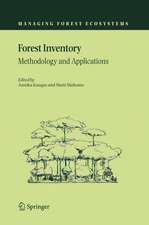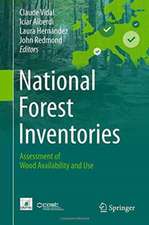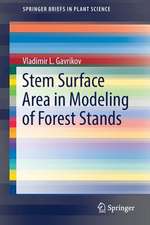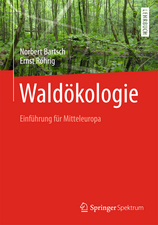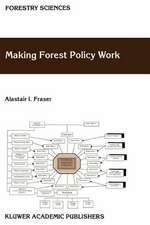Forestry Applications of Airborne Laser Scanning: Concepts and Case Studies: Managing Forest Ecosystems, cartea 27
Editat de Matti Maltamo, Erik Næsset, Jari Vauhkonenen Limba Engleză Hardback – 23 apr 2014
| Toate formatele și edițiile | Preț | Express |
|---|---|---|
| Paperback (1) | 953.03 lei 6-8 săpt. | |
| SPRINGER NETHERLANDS – 18 sep 2016 | 953.03 lei 6-8 săpt. | |
| Hardback (1) | 967.08 lei 6-8 săpt. | |
| SPRINGER NETHERLANDS – 23 apr 2014 | 967.08 lei 6-8 săpt. |
Din seria Managing Forest Ecosystems
- 18%
 Preț: 945.79 lei
Preț: 945.79 lei - 18%
 Preț: 1394.03 lei
Preț: 1394.03 lei -
 Preț: 367.68 lei
Preț: 367.68 lei - 18%
 Preț: 1113.71 lei
Preț: 1113.71 lei - 15%
 Preț: 642.21 lei
Preț: 642.21 lei -
 Preț: 431.74 lei
Preț: 431.74 lei - 24%
 Preț: 1042.42 lei
Preț: 1042.42 lei - 15%
 Preț: 711.21 lei
Preț: 711.21 lei - 24%
 Preț: 787.53 lei
Preț: 787.53 lei - 15%
 Preț: 646.62 lei
Preț: 646.62 lei - 15%
 Preț: 645.60 lei
Preț: 645.60 lei - 18%
 Preț: 1242.03 lei
Preț: 1242.03 lei - 15%
 Preț: 648.24 lei
Preț: 648.24 lei - 15%
 Preț: 693.90 lei
Preț: 693.90 lei - 24%
 Preț: 799.26 lei
Preț: 799.26 lei - 18%
 Preț: 1229.10 lei
Preț: 1229.10 lei - 18%
 Preț: 943.43 lei
Preț: 943.43 lei - 18%
 Preț: 948.92 lei
Preț: 948.92 lei - 24%
 Preț: 778.93 lei
Preț: 778.93 lei - 18%
 Preț: 945.62 lei
Preț: 945.62 lei - 18%
 Preț: 943.88 lei
Preț: 943.88 lei - 18%
 Preț: 1544.00 lei
Preț: 1544.00 lei - 18%
 Preț: 946.55 lei
Preț: 946.55 lei - 18%
 Preț: 1244.71 lei
Preț: 1244.71 lei - 18%
 Preț: 949.73 lei
Preț: 949.73 lei - 24%
 Preț: 849.89 lei
Preț: 849.89 lei - 24%
 Preț: 903.00 lei
Preț: 903.00 lei - 18%
 Preț: 952.26 lei
Preț: 952.26 lei - 20%
 Preț: 592.60 lei
Preț: 592.60 lei
Preț: 967.08 lei
Preț vechi: 1179.37 lei
-18% Nou
Puncte Express: 1451
Preț estimativ în valută:
185.05€ • 193.21$ • 153.15£
185.05€ • 193.21$ • 153.15£
Carte tipărită la comandă
Livrare economică 05-19 aprilie
Preluare comenzi: 021 569.72.76
Specificații
ISBN-13: 9789401786621
ISBN-10: 9401786623
Pagini: 476
Ilustrații: IX, 464 p. 84 illus., 39 illus. in color.
Dimensiuni: 155 x 235 x 31 mm
Greutate: 1.07 kg
Ediția:2014
Editura: SPRINGER NETHERLANDS
Colecția Springer
Seria Managing Forest Ecosystems
Locul publicării:Dordrecht, Netherlands
ISBN-10: 9401786623
Pagini: 476
Ilustrații: IX, 464 p. 84 illus., 39 illus. in color.
Dimensiuni: 155 x 235 x 31 mm
Greutate: 1.07 kg
Ediția:2014
Editura: SPRINGER NETHERLANDS
Colecția Springer
Seria Managing Forest Ecosystems
Locul publicării:Dordrecht, Netherlands
Public țintă
GraduateCuprins
1. Introduction to forest applications of airborne laser scanning; Jari Vauhkonen et al.- PART I – Methodological issues.- 2. Laser pulse interaction with forest canopy – geometric and radiometric issues; Andreas Roncat et al.- 3. Full-waveform airborne laser scanning systems and their possibilities in forest applications; Markus Hollaus et al.- 4. Integrating airborne laser scanning with data from global navigation satellite systems and optical sensors; Rubén Valbuena.- 5. Segmentation of forest to tree objects; Barbara Koch et al.- 6. The semi-individual tree crown approach; Johannes Breidenbach, Rasmus Astrup.- 7. Tree species recognition based on airborne laser scanning and complementary data sources; Jari Vauhkonen et al.- 8. Estimation of biomass components by airborne laser scanning; Sorin C. Popescu, Marius Hauglin.- 9. Predicting tree diameter distributions; Matti Maltamo, Terje Gobakken.- 10. A model-based approach for the recovery of forest attributes using airborne laser scanning data; Lauri Mehtätalo et al.- PART II – Forest inventory applications.- 11. Area-based inventory in Norway - from innovation to an operational reality; Erik Næsset.- 12. Species specific management inventory in Finland; Matti Maltamo, Petteri Packalen.- 13. Inventory of forest plantations; Jari Vauhkonen et al.- 14. Using airborne laser scanning data to support forest sample surveys; Ronald E. McRoberts et al.- 15. Modeling and estimating change; Ronald E. McRoberts et al.- 16. Valuation of airborne laser scanning based forest information; Annika Kangas et al.- PART III – Ecological applications.- 17. Assessing habitats and organism-habitat relationships by airborne laser scanning; Ross A. Hill et al.- 18. Assessing biodiversity by airborne laser scanning; Jörg Müller, Kerri Vierling.- 19. Assessing deadwood by airborne laser scanning; Matti Maltamo et al.- 20. Estimation of canopy cover, gap fraction and leaf area index with airborne laser scanning; Lauri Korhonen, Felix Morsdorf.- 21. Canopy gap detection and analysis with airborne laser scanning; Benoît St-Onge et al.- 22. Applications of airborne laser scanning in forest fuel assessment and fire prevention; John Gajardo et al.- Index.
Textul de pe ultima copertă
Airborne laser scanning (ALS) has emerged as one of the most promising remote sensing technologies to provide data for research and operational applications in a wide range of disciplines related to management of forest ecosystems. This book provides a comprehensive, state-of-the-art review of the research and application of ALS in a broad range of forest-related disciplines. However, this book is more than just a collection of individual contributions – it consists of a well-composed blend of chapters dealing with fundamental methodological issues and contributions reviewing and illustrating the use of ALS within various domains of application.
The main aim of this book is to provide the scientific and technical background of ALS with a particular focus on applicability in operational forestry. Most of the chapters are devoted to applications in forest inventory and forest ecology such as forest management inventory and assessments of canopy cover, habitats and organism-habitat relationships. Many of the chapters focus on boreal forests simply because methods were initially developed for boreal conditions. However, examples show the most common applications of ALS at various geographical scales; from individual trees, to forest stands, regions and nations. The reviews provide a comprehensive and unique overview of recent research and applications that researchers, students and practitioners of forest remote sensing and forest ecosystem assessment should consider as a useful reference text.
The main aim of this book is to provide the scientific and technical background of ALS with a particular focus on applicability in operational forestry. Most of the chapters are devoted to applications in forest inventory and forest ecology such as forest management inventory and assessments of canopy cover, habitats and organism-habitat relationships. Many of the chapters focus on boreal forests simply because methods were initially developed for boreal conditions. However, examples show the most common applications of ALS at various geographical scales; from individual trees, to forest stands, regions and nations. The reviews provide a comprehensive and unique overview of recent research and applications that researchers, students and practitioners of forest remote sensing and forest ecosystem assessment should consider as a useful reference text.
Caracteristici
First comprehensive textbook about forest applications of airborne laser scanning The writers of the book are worldwide known experts of the area All topics are covered from both theoretical and practical perspectives
